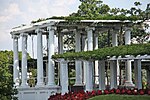Grave of Robert F. Kennedy

The grave of Robert F. Kennedy is a historic grave site and memorial to assassinated United States Senator and 1968 Democratic presidential candidate Robert F. Kennedy located in section 45 of Arlington National Cemetery in Arlington County, Virginia, in the United States. It was dedicated on December 6, 1971, and replaced a temporary grave in which Kennedy was originally buried on June 8, 1968. It is adjacent to the John F. Kennedy Eternal Flame. The grave is aligned along an east–west axis, roughly along the line of sight between Arlington House and the Jefferson Memorial. The grave consists of an unadorned, white wooden cross at the head of the grave and a simple grey granite marker set flush with the earth at the foot of it. The memorial consists of a small semicircular granite plaza, which provides viewing for the grave. At the back (straight) axis of the plaza is a low rectangular grey granite wall inscribed with quotations from two of Kennedy's speeches. A small, rectangular reflecting pool is at the base of the wall.
Excerpt from the Wikipedia article Grave of Robert F. Kennedy (License: CC BY-SA 3.0, Authors, Images).Grave of Robert F. Kennedy
Sheridan Drive, Arlington
Geographical coordinates (GPS) Address Nearby Places Show on map
Geographical coordinates (GPS)
| Latitude | Longitude |
|---|---|
| N 38.881194444444 ° | E -77.071472222222 ° |
Address
Robert F. Kennedy
Sheridan Drive
22211 Arlington
Virginia, United States
Open on Google Maps










